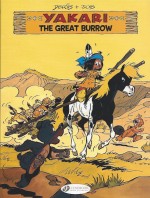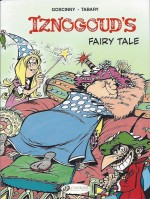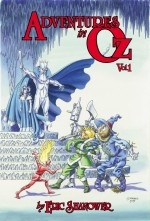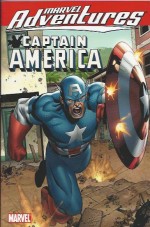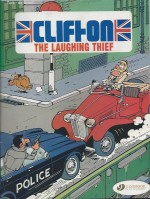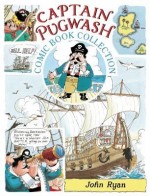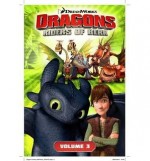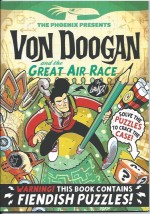
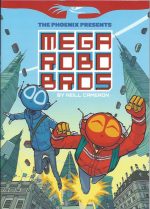
By Neill Cameron with Lisa Murphy (David Fickling Books)
ISBN: 978-1-910200-83-4
In 2012 David Fickling Books launched a traditional anthology comic for girls and boys reviving the good old days of picture-story entertainment Intent whilst embracing the full force of modernity in terms of delivery and Content. Each strip-packed issue of The Phoenix offers humour, adventure, quizzes, puzzles and educational material in a joyous parade of cartoon fun and fantasy. In the years since its premiere, the magazine has gone from strength to strength, winning praise from the Great and the Good, child literacy experts and the only people who actually matter – the perpetually-engaged kids and parents who read it every week…
Just like the golden age of Beano, Dandy and other childhood treasures, The Phoenix masterfully manages the magical trick of marrying hilarious comedy with enthralling adventure serials… sometimes in the same scintillating strip such as the stars of this latest compilation: a mega-magnificent sci fi frolic packed into an extra-long full-colour lexicon of high-octane comedy-action.
Plunging straight into the enchanting immersive experience, we open in a futuristic London on a Monday morning. Alex and his younger brother Freddie have missed the airbus for school and dad has to take them. It’s a uniquely Sharma-family catastrophe…
In most ways the boys are typical: boisterous, fractious kids, always arguing, but devoted to each other and not too bothered that they’re adopted. It’s also no big deal to them that they were created by the mysterious Dr. Roboticus before he vanished and are considered by those in the know as the most powerful robots on Earth.
For now though it’s enough that Mum and Dad love them, even though the Robo Bros are a bit more of a handful than most kids. They live as normal a life as possible; going to school, making friends, putting up with bullies and hating homework: it’s all part of the ‘Mega Robo Routine’…
This week, however, things are a little different. On Wednesday the lads meet Baroness Farooq of covert agency R.A.I.D. (Robotics Analysis Intelligence and Defence) who is initially unimpressed but changes her mind after seeing what they do to her squad of Destroyer Mechs – all while between singing rude songs, reading comics and squabbling with each other.
Thursday is even better. As a treat, the entire family goes to Robo World where little Freddy rescues a trio of malfunctioning exhibits. The baby triceratops with dog-programming is ok, but the French-speaking deranged ape and gloomy existentialist penguin will be a handful…
And all because Mum was trying to explain how her sons’ sentience makes them different from all other mechanoids…
Friday wasn’t so good. Alex had another one of his nightmares, of the time before they came to live with the Sharmas…
With the scene exquisitely set, the drama kicks into overdrive with ‘Mega Robo School Trip’ as a visit to the museum gives a hidden menace watching the boys the opportunity to create chaos by hacking the exhibits and forcing the boys to use all their super-powers to set things right. It takes all of the Baroness’ astounding influence to hush up the incident. The boys are supposed to be getting as normal a childhood as possible, with friends and family aware that they’re artificial and sentient, but not that they are unstoppable weapons systems.
Now some malign force seems determined to “out†the Robo Bros for an unspecified but undoubtedly sinister purpose…
Even greater cloaking measures are necessary when the enemy causes a sky-train crash and the boys very publicly prevent a ‘Mega Robo Disaster’, but even they are starting to realise something big is up and Mum is a bit extraordinary herself.
Then Freddy overhears some disturbing news about another one of Dr. Roboticus’ other creations in ‘Mega Robo Full House’…
The crisis comes in ‘Mega Robo Royal Rumble’ after Gran takes Alex and Freddy to a Royal Street Party outside Buckingham Palace. When the hidden enemy hacks the giant robot guards and sets them loose on the Queen and her family, the wonder-bots have to save them on live TV beamed around the world. The secret is out…
Now the entire world is camped outside their quiet little house, so Mum has R.A.I.D. restore some semblance of the ‘Mega Robo Status Quo’ by building a super-secret tunnel system in the cellar. It’s a big day all around: Farooq is finally convinced that Alex is at last ready to join R.A.I.D. as a full-fledged operative… after school and on weekends, of course…
Freddy is far from happy to learn that he’s not invited. The Baroness still considers him too young and immature…
He quickly proves it when big brother Alex becomes the ‘Mega Robo Secret Agent’. Freddy at last shares with dad the real reason he’s acting up, but has the opportunity to redeem himself and save the day when the ‘Mega Robo Nemesis’ at last makes his move and Alex finds himself completely out of his depth. Then only Freddy can save the day… if anyone can…
Written and drawn by Neill Cameron (Tamsin of the Deep, How to Make Awesome Comics, Pirates of Pangea), this is an astonishingly engaging tale which rockets along, blending outrageous comedy with warmth, wit and incredible verve. Alex and Freddy are utterly authentic boys, irrespective of their artificial origins, and their exploits strike exactly the right balance of future shock, family fun and bombastic superhero action to capture readers’ hearts and minds. With the right budget and producer what a movie this would make!
Unmissable excitement for kids of all ages and vintage, this is a true “must-have†item.
Text and illustrations © Neill Cameron 2016. All rights reserved.
Mega Robo Bros will be released on June 2nd 2016 and is available for pre-order now.

